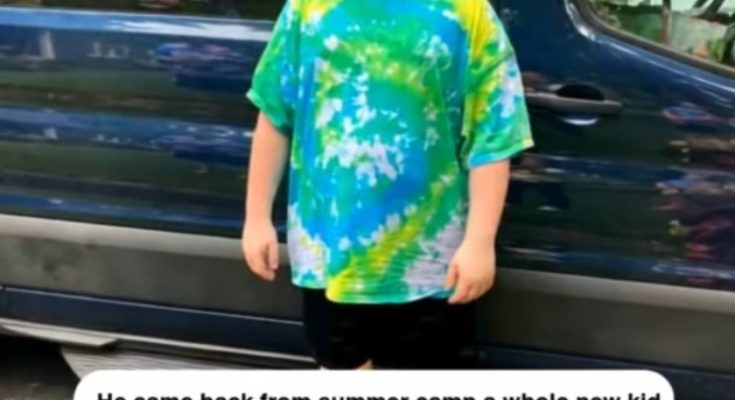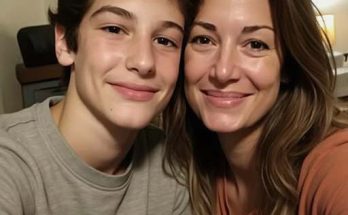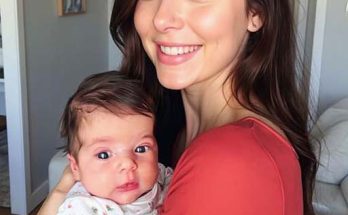He came back from summer camp a whole new kid—confident, shaved head, that tie-dye shirt he wouldn’t take off. “I made it in Cabin Six,” he said proudly. Later, while doing laundry, I noticed faded names scribbled inside the collar. One was underlined twice. I Googled it—and the first result was an article titled, “Boy Missing From Cabin Six Since…”
I froze right there in the laundry room, the hum of the dryer suddenly sounding louder than usual. My heart pounded as I read the headline again, making sure my eyes weren’t playing tricks on me. It was an old news clipping, dated twelve years ago. The boy’s name matched the one scribbled underlined twice in the shirt’s collar. He had vanished one night at camp, never to be found.
I stared at the tie-dye shirt in my hands, trying to steady my breathing. My son, Ryan, was only ten. He had returned from camp happier than I’d seen him in years—laughing more, talking more, standing taller. And here I was, holding something that connected him to a child who had never come home.
When I asked him casually about the shirt, Ryan just shrugged. “We all made them on the last day. Cabin Six shirts. Everyone signed each other’s.” That seemed harmless enough, except the names weren’t written in Sharpie by kids that summer. They were faded, almost washed out, like they’d been there for over a decade.
I didn’t want to scare him, so I dropped it for the moment. But later that night, after he’d gone to bed, I went back to my laptop and dug deeper. The missing boy’s name was Evan. He was twelve when he disappeared. According to the article, he had last been seen heading to the lake after lights out. His shoes were found on the dock, but he never returned to the cabin. No body was ever recovered.
The next morning, I decided I needed answers. I called the camp under the pretense of asking about lost-and-found items. The woman who answered sounded cheerful, but when I asked specifically about Cabin Six and the tie-dye shirts, her tone shifted slightly. “Cabin Six doesn’t exist anymore,” she said. “We closed it years ago. Where did you say your son stayed?”
I swallowed hard. “Cabin Six,” I repeated.
There was a long pause. “Ma’am, are you certain? Cabin Six was boarded up after… after the incident. Campers don’t stay there.”
I hung up, my hands shaking. Had Ryan imagined it? Was the camp running it secretly? Or worse—had they sent him into a place they didn’t want to admit still existed?
That evening, I sat Ryan down and asked him again about camp. I encouraged him to tell me more about Cabin Six—who his bunkmates were, what his counselor was like, what they did for fun. He spoke animatedly, describing games, late-night ghost stories, and how his counselor, a tall teenager named Ben, always wore a baseball cap.
But here was the strange part—every time I asked for specific names of other kids, Ryan hesitated. “I can’t remember their last names,” he admitted. “But they were cool. We talked a lot.” He listed a few first names, including Evan. My stomach dropped.
I tried not to show my alarm, but later that night, I confided in Thomas, my husband. He thought I was overreacting. “Kids make things up. Maybe Ryan saw the name somewhere and copied it onto the shirt,” he suggested. But even he looked uneasy when I showed him the online article.
Still, I couldn’t let it go. The next weekend, I drove out to the camp myself. It was closed for the season, the gates chained, but the surrounding woods were easy to slip through. I walked until I found the cabins. Sure enough, Cabin Six was there—but boarded up, just as the woman on the phone had said. The wood was weathered, the windows covered, but the number six was still faintly visible above the door.
I walked around the building, and that’s when I saw it. A small piece of tie-dye fabric caught in the splintered wood of the back wall, faded but unmistakable. My heart thudded. Someone had been here, recently enough for the cloth to still hold color.
Back home, I kept my discovery to myself. I didn’t want to frighten Ryan. But I paid closer attention when he wore the shirt. Sometimes he’d sit on the porch, staring off into the distance, humming a tune I didn’t recognize. When I asked him about it, he’d smile and say, “It’s from camp. Evan taught me.”
Weeks passed. One night, Ryan woke up screaming. I rushed into his room and found him trembling, clutching the shirt in his hands. “He wants to go home,” Ryan whispered through tears. “He says he can’t find the dock.”
I held him, my mind racing. Was this the imagination of a child who’d heard ghost stories—or something deeper?
The next day, I made a decision. I returned to the camp, this time with Ryan. I told Thomas we were going for a hike, but I knew exactly where we were headed. Ryan seemed nervous as we approached the cabins, his usual chatter gone. When we reached Cabin Six, he stopped in his tracks.
“This is it,” he said quietly. “But it doesn’t look the same.”
“What do you mean?” I asked.
“It wasn’t broken down like this. The windows were fine. The beds were made. Ben was here.” He frowned, confused. “Why does it look so old now?”
My heart pounded. I didn’t have an answer.
I led him to the lake. The dock stretched out into the water, weathered but sturdy. Ryan stood at the edge, clutching the shirt. He whispered something I couldn’t hear, then suddenly tossed the shirt into the water. It floated for a moment, then slowly sank beneath the surface.
That night, for the first time since camp, Ryan slept soundly. No nightmares, no whispers.
I thought maybe it was over. But a week later, a package arrived in the mail. No return address. Inside was the tie-dye shirt—dry, folded neatly, with the names inside the collar even more faded than before. My hands shook as I held it. Ryan walked in, saw the shirt, and smiled. “He found the dock,” he said simply.
From then on, he never mentioned Evan again. The shirt stayed folded in his drawer, untouched. Ryan’s confidence remained, but the odd detachment he’d carried since camp faded. He was just Ryan again—still a little braver, still humming now and then, but grounded.
I never told Thomas about the package. I never called the camp again. Some things don’t have neat explanations, and I wasn’t sure I wanted one.
Years later, when Ryan was packing for college, I found the shirt tucked in the bottom of his dresser. He held it up thoughtfully. “I think I’ll take it with me,” he said. “It reminds me that I can get through anything.”
I asked if he remembered much about Cabin Six. He shook his head. “Not really. Just that it felt… different. Like I wasn’t alone, even when I was scared.”
He left, and I sat there with the shirt in my hands one last time. The names were nearly invisible now, only faint traces left. But I traced the underlined one—Evan—and whispered a quiet thank you.
Because whatever had happened that summer, whoever had walked alongside my son, it had left him stronger. And it had left me with a lesson I’ll never forget.
Sometimes the past lingers in unexpected ways. Sometimes it asks to be remembered, not to haunt, but to guide. And sometimes, the kindness we show—or the attention we give—can help carry someone, even long after they’re gone.
Ryan still wears tie-dye sometimes. Whenever I see it, I’m reminded that even the strangest, most unsettling experiences can carry meaning. That shirt wasn’t just fabric and dye—it was a bridge, however brief, between two boys separated by time.
And I learned that not every mystery needs to be solved to have value. Some just need to be honored.
If this story touched you, share it with someone who believes in the quiet power of connection. And if you’ve ever felt the past brushing against your present, let it remind you—life has layers we can’t always explain, but every layer has something to teach us.



